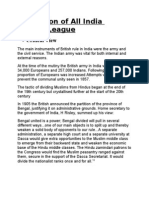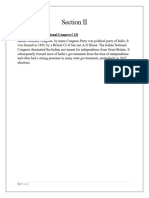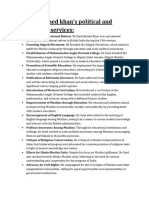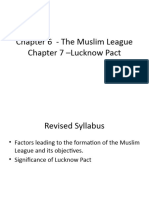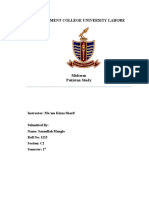0 ratings0% found this document useful (0 votes)
12 viewsLecture 3
Lecture 3
Uploaded by
6pgztw57q7Copyright:
© All Rights Reserved
Available Formats
Download as PDF, TXT or read online from Scribd
Lecture 3
Lecture 3
Uploaded by
6pgztw57q70 ratings0% found this document useful (0 votes)
12 views15 pagesCopyright
© © All Rights Reserved
Available Formats
PDF, TXT or read online from Scribd
Share this document
Did you find this document useful?
Is this content inappropriate?
Copyright:
© All Rights Reserved
Available Formats
Download as PDF, TXT or read online from Scribd
Download as pdf or txt
0 ratings0% found this document useful (0 votes)
12 views15 pagesLecture 3
Lecture 3
Uploaded by
6pgztw57q7Copyright:
© All Rights Reserved
Available Formats
Download as PDF, TXT or read online from Scribd
Download as pdf or txt
You are on page 1of 15
Historical background leading
to the creation of Pakistan
Lecture 2
Instructor: Ammar Yasir
Partition of Bengal (1905):
• The Partition of Bengal in 1905 was a significant administrative
reorganization undertaken by the British colonial government in
India. The province of Bengal, which at the time was one of the
largest and most populous provinces in British India, was divided into
two separate entities: Eastern Bengal and Assam, with Dhaka as its
capital, and the rest of Bengal which retained the name "Bengal".
• The stated rationale behind this partition was to improve
administrative efficiency by creating smaller, more manageable
administrative units.
Cont…
• However, the real motivations behind the partition were more
complex and rooted in British colonial policies of divide and rule and
their apprehensions about growing nationalist sentiments in the
region.
• Divide and Rule: The British employed a divide and rule strategy to
maintain control over their vast colonial territories. By creating
divisions along ethnic, religious, or linguistic lines, they sought to
prevent the emergence of a united Indian nationalist movement that
could challenge their authority. The Partition of Bengal was seen as a
way to weaken the cohesion of the Bengali-speaking population,
which was considered a hotbed of nationalist sentiment.
• Economic Considerations: There were also economic factors at play.
Bengal was a prosperous province with a thriving economy based on
agriculture and industry. The partition was perceived as a move to
safeguard the economic interests of the British by creating separate
administrative units that could be more easily controlled and
exploited.
• Fear of Nationalist Movement: Bengal, particularly Calcutta (now
Kolkata), had emerged as a centre of the Indian nationalist
movement, with leaders like Rabindranath Tagore, Surendranath
Banerjee, and Aurobindo Ghosh playing prominent roles. The British
viewed the growing nationalist sentiment with concern and saw the
partition as a way to disrupt and weaken the movement by creating
divisions along religious lines.
• Communal Tensions: One of the unintended consequences of the
partition was the exacerbation of communal tensions between
Hindus and Muslims. The division of Bengal resulted in a
Hindu-majority western region and a Muslim-majority eastern region.
This sparked fears and insecurities among both communities about
their political and cultural identity, leading to heightened communal
tensions.
• Impact on Muslim Identity: The creation of East Bengal and Assam,
with Dhaka as its capital, provided a political space for Muslim
identity to assert itself more prominently. This event laid the
groundwork for future demands for separate Muslim-majority
regions and sowed the seeds for the eventual partition of British India
and the creation of Pakistan.
• Formation of the Muslim League (1906):
• The All-India Muslim League emerged in 1906 as a political organization
representing the interests and concerns of Muslims in British India. It was
established in Dhaka during the annual session of the All India
Muhammadan Educational Conference, with prominent Muslim leaders
and intellectuals like Nawab Salimullah Khan and Aga Khan III playing key
roles.
• The formation of the Muslim League was a response to the perceived
marginalization of Muslims within the broader Indian nationalist
movement dominated by the Indian National Congress, which primarily
comprised Hindu leaders.
• Muslims felt the need for a separate political platform to safeguard their
rights, promote their interests, and articulate their distinct identity within
the diverse Indian society under British colonial rule.
Cont…
• The Muslim League's agenda evolved, reflecting the changing political landscape
of British India. Initially, it aimed to secure adequate political representation and
safeguards for Muslims within a united India.
• The League advocated for separate electorates, where Muslims could vote for
their representatives, as well as safeguards for their cultural and religious rights.
• However, as communal tensions between Hindus and Muslims intensified and the
Indian nationalist movement became increasingly dominated by Hindu leadership,
the Muslim League's demands for greater autonomy and safeguards for Muslims
grew stronger.
• Ultimately, the League became the leading voice for the demand for a separate
Muslim-majority nation-state, leading to the eventual creation of Pakistan in
1947. The Muslim League's formation and its evolving agenda played a crucial role
in shaping the trajectory of Indian politics and the struggle for independence from
British colonial rule.
Lucknow Pact 1916
•
The Lucknow Pact of 1916 marked a significant milestone in Indian politics as
it represented a rare moment of collaboration and cooperation between the
Indian National Congress (INC) and the All-India Muslim League (AIML).
Negotiated during the Lucknow Session of the INC, the pact aimed to address
the concerns of both Hindu and Muslim communities within the context of
British colonial rule.
• One of the key agreements reached in the Lucknow Pact was the
endorsement of separate electorates for Muslims, a longstanding demand of
the Muslim League. This meant that Muslim voters would have the right to
elect their own representatives in designated constituencies, distinct from
those elected by Hindu voters.
• Additionally, the pact proposed a system of "weightage" whereby seats in
legislative bodies would be allocated to Muslims in proportion to their
population, ensuring adequate representation for the Muslim community.
• In constituencies where Muslims were in a minority, joint electorates
were proposed, allowing voters from all communities to participate in
electing representatives.
• The Lucknow Pact also aimed to foster Hindu-Muslim unity by
recognizing and accommodating the interests of both communities. It
was a significant step towards bridging the gap between Hindus and
Muslims within the Indian nationalist movement.
• Despite their differences, the INC and the AIML demonstrated a
willingness to cooperate and collaborate for the greater cause of
Indian independence. The pact symbolized a broader effort to
promote communal harmony and inclusivity, recognizing the diversity
of Indian society.
Khilafat Movement
• The Khilafat Movement was a significant pan-Islamic political
campaign launched in India in the aftermath of World War I. It
emerged as a response to the imminent threat to the Ottoman
Caliphate, the spiritual leader of the global Muslim community, by
the Allied Powers.
• Indian Muslims, led by prominent leaders such as the Ali brothers
(Maulana Muhammad Ali and Maulana Shaukat Ali) and Abul Kalam
Azad, rallied to support the Caliphate, viewing its preservation as
crucial to the interests and dignity of Muslims worldwide.
• The movement gained widespread traction, with Muslims across
India organizing protests, boycotts, and demonstrations to express
solidarity with the Ottoman Empire and to pressure the British
colonial authorities to intervene on behalf of the Caliphate.
Failure
• The Chauri Chaura incident of 1922, where protesters clashed with
police resulting in the deaths of numerous policemen, prompted
Mahatma Gandhi to call off the Non-Cooperation Movement, a
campaign deeply intertwined with the Khilafat Movement. This
decision was a significant setback for both movements as it halted the
momentum of mass mobilization and civil disobedience against
British colonial rule.
• While the Khilafat Movement initially fostered Hindu-Muslim unity
and collaboration, its ultimate inability to achieve its goals
contributed to a sense of frustration and division within Indian
nationalist circles, underscoring the complexities of communal
politics in the struggle for independence.
Cabinet Mission Plan
• The Cabinet Mission Plan of 1946 was a crucial attempt by the British
government to address the growing demand for Indian independence and
to find a viable constitutional framework for post-colonial governance. The
plan proposed a federal system for India, intending to grant significant
autonomy to provinces while retaining a central government responsible
for defense, foreign affairs, and communications.
• Provinces were to be grouped into three categories based on their
demographics and administrative needs, with Group A provinces having
more autonomy than Groups B and C. Additionally, the plan proposed the
establishment of an interim government comprising members of the Indian
National Congress and the Muslim League, intending to draft a constitution
for independent India.
Partition and Independence 1947
• The Partition of British India in 1947 was accompanied by widespread
violence, displacement, and loss of life, resulting in one of the largest and
most traumatic population transfers in history. While exact statistics vary,
it is estimated that between 10 to 15 million people were displaced, and
anywhere from 1 to 2 million people lost their lives due to the violence and
its aftermath.
• The communal violence that erupted during the Partition led to horrifying
atrocities, including mass killings, rapes, abductions, and forced
conversions. Entire communities were targeted based on religious identity,
leading to the destruction of homes, villages, and livelihoods.
• Women and children were particularly vulnerable to violence and
exploitation, with countless cases of sexual violence and abduction
reported. The scale and intensity of the violence left deep scars on the
collective memory of those who witnessed or experienced it, traumatizing
entire generations
Cont…
• The partition also resulted in immense human suffering and
displacement. Millions of people were uprooted from their homes
and forced to embark on arduous journeys across newly drawn
borders in search of safety.
• Many lost their lives during these journeys due to violence, disease,
and starvation. The mass migration led to overcrowded refugee
camps and strained resources, exacerbating the humanitarian crisis.
The trauma of displacement and loss continues to impact
communities on both sides of the border, shaping their identities,
narratives, and relationships with their neighbours.
Questions?
You might also like
- Contemporary Thought in The Muslim WorldDocument56 pagesContemporary Thought in The Muslim WorldZaky MuzaffarNo ratings yet
- UntitledDocument8 pagesUntitledSujata SgNo ratings yet
- ICP All Important Points SummarizationDocument8 pagesICP All Important Points Summarizationhhi33027No ratings yet
- Early History and Pakistan MovementDocument31 pagesEarly History and Pakistan MovementShahriar HasanNo ratings yet
- 6partition of India PSC 301 Spring 2020Document19 pages6partition of India PSC 301 Spring 2020Muhammad Majid Zaheer100% (1)
- HistoryDocument62 pagesHistoryM. TalhaNo ratings yet
- Partition of Bengal - 1905Document28 pagesPartition of Bengal - 1905Reshan ChowdhuryNo ratings yet
- Unit 4 CommunalismDocument13 pagesUnit 4 CommunalismNeeraj LatwalNo ratings yet
- Partitions_(1905,1947)Document4 pagesPartitions_(1905,1947)ahmed.mcj.duNo ratings yet
- Pakistan Movement: Evolution of Muslim Nationality (1857 To 1930) War of IndependenceDocument9 pagesPakistan Movement: Evolution of Muslim Nationality (1857 To 1930) War of IndependenceMuhammad AsifNo ratings yet
- Partition of Bengal - 1905Document23 pagesPartition of Bengal - 1905jahedul IslamNo ratings yet
- Topic 1 & 2-Bengal Partition and Formation of Muslim LeagueDocument14 pagesTopic 1 & 2-Bengal Partition and Formation of Muslim LeagueIrfanul H ShiamNo ratings yet
- Muslim LeagueDocument7 pagesMuslim Leagueluffykaizo9369No ratings yet
- TextDocument3 pagesTextzainabgulfam786No ratings yet
- Divide and RuleDocument2 pagesDivide and Rulekiran shahzadiNo ratings yet
- The Partition of BengalDocument10 pagesThe Partition of BengalMary QuinnNo ratings yet
- Partition of Bengal (1905-1911) and The Emergence of East BengalDocument30 pagesPartition of Bengal (1905-1911) and The Emergence of East BengalMirza Asir IntesarNo ratings yet
- Class 05 - Birth of Pakistan 1947, Spring 2020Document39 pagesClass 05 - Birth of Pakistan 1947, Spring 2020FARHAN TANJIM AHMED 1712304630No ratings yet
- Fahad PST 1 Section 2Document63 pagesFahad PST 1 Section 2Mariam AfzalNo ratings yet
- Advocacy For Educational Reform Sir Syed Ahmad Khan Was A PRDocument23 pagesAdvocacy For Educational Reform Sir Syed Ahmad Khan Was A PRbhalwawhalesNo ratings yet
- Communalism in Indian PoliticsDocument8 pagesCommunalism in Indian PoliticsParidhi JainNo ratings yet
- His103. AQR1Document10 pagesHis103. AQR1Mohammad Khalid Bin Habib (Dhruvo)No ratings yet
- History Chap 6 NotesDocument9 pagesHistory Chap 6 Notesumais kamranNo ratings yet
- Introduction To Ideology of PakistanDocument21 pagesIntroduction To Ideology of PakistanMohammad Kashif KhanNo ratings yet
- Munalism & Partition Politics 1Document22 pagesMunalism & Partition Politics 1gtxtahmid802No ratings yet
- The Aligarh MovementDocument14 pagesThe Aligarh Movementnoorsarwar789No ratings yet
- SSSDocument12 pagesSSS2022337020No ratings yet
- Pakistan & Modern South Asia: Week 8 - Challenge and RuptureDocument30 pagesPakistan & Modern South Asia: Week 8 - Challenge and RuptureArsalan AhmedNo ratings yet
- 5.the Muslim LeagueDocument8 pages5.the Muslim Leagueayushsardesai9No ratings yet
- BHC 101-Chapter 2Document7 pagesBHC 101-Chapter 2sktanvirbd25No ratings yet
- ICSE History Chapter 7 and 6Document14 pagesICSE History Chapter 7 and 6nihaaltitkareNo ratings yet
- 3 & 4 Important Events in SubcontinentDocument25 pages3 & 4 Important Events in SubcontinentMaZ3 PlaYZNo ratings yet
- lecture 3,4Document33 pageslecture 3,4haniaqasim70No ratings yet
- Muslim LeagueDocument5 pagesMuslim LeagueAnupam RoyNo ratings yet
- Fahad PST 1 Section 2Document63 pagesFahad PST 1 Section 2aamirbwp105No ratings yet
- Lecture 3 Different Political Movements Before Pakistan-Part IDocument14 pagesLecture 3 Different Political Movements Before Pakistan-Part IsabaNo ratings yet
- History Project FinalDocument11 pagesHistory Project FinalmalhotraamyiaNo ratings yet
- Partition of Bengal and Reversal 1905-11Document48 pagesPartition of Bengal and Reversal 1905-11XPhysixZNo ratings yet
- Updated_Answers_to_Questions (1)Document4 pagesUpdated_Answers_to_Questions (1)SheraNo ratings yet
- Causes of The Partition of IndiaDocument18 pagesCauses of The Partition of IndiaCHHOTE LAL SHAWNo ratings yet
- Lucknow PactDocument38 pagesLucknow PactAamir MehmoodNo ratings yet
- Muslims Political StruggleDocument33 pagesMuslims Political StruggleJaveria AwanNo ratings yet
- Sec IiDocument102 pagesSec Iimuhammad umarNo ratings yet
- History ch-5Document11 pagesHistory ch-5Sadik farhat MollaNo ratings yet
- Major Political Developments 1857-1918Document3 pagesMajor Political Developments 1857-1918Muhammad TaimurNo ratings yet
- 5 Musplim LeagueDocument10 pages5 Musplim LeagueMohanaSundaram RNo ratings yet
- History-Draft 2023-24 Partition of IndiaDocument12 pagesHistory-Draft 2023-24 Partition of IndiaLokeshNo ratings yet
- VSLLS Yp HCC BGDocument14 pagesVSLLS Yp HCC BGks064655No ratings yet
- Reasons For The Establishment of The Muslim League Chap 6Document22 pagesReasons For The Establishment of The Muslim League Chap 6afnan.6556No ratings yet
- Sanaullah 1215 (Pak Study)Document6 pagesSanaullah 1215 (Pak Study)Ayaz MangloNo ratings yet
- Pakistan Affair Solved Paper 2000 2001 2002Document40 pagesPakistan Affair Solved Paper 2000 2001 2002shahab khanNo ratings yet
- The Emergence of Communal Politics: Dr. M Humayun KabirDocument29 pagesThe Emergence of Communal Politics: Dr. M Humayun Kabirabdullah islamNo ratings yet
- Topic 8 Lahore ResolutionDocument8 pagesTopic 8 Lahore ResolutionMosaddik Habib 2021783630No ratings yet
- Growth of Communalism in National Movement PDF PrintDocument5 pagesGrowth of Communalism in National Movement PDF PrintAKANKSHA SINGH 2357305No ratings yet
- Partition of BangladeshDocument4 pagesPartition of BangladeshSajjadul IslamNo ratings yet
- Minto Morley ReformsDocument5 pagesMinto Morley Reformsabdul samadNo ratings yet
- His-103 Mid ExaminationDocument7 pagesHis-103 Mid ExaminationNazmul Hasan ShaikotNo ratings yet
- Muhammad Ali JINNAHDocument17 pagesMuhammad Ali JINNAHMumtaz SajidNo ratings yet
- Final Assessment: Government College University LahoreDocument12 pagesFinal Assessment: Government College University LahoreAyaz MangloNo ratings yet
- Religious Conversion in India: The Niyogi Committee Report of Madhya Pradesh in 1956 and Its Continuing Impact on National UnityFrom EverandReligious Conversion in India: The Niyogi Committee Report of Madhya Pradesh in 1956 and Its Continuing Impact on National UnityNo ratings yet
- Komunikasi Agama R.A. Kartini Kepada Nyonya Abendanon-MandriDocument20 pagesKomunikasi Agama R.A. Kartini Kepada Nyonya Abendanon-MandriSagar SegerNo ratings yet
- The Land of Five Towers Book ReviewDocument3 pagesThe Land of Five Towers Book ReviewDery PutraNo ratings yet
- ForewordDocument2 pagesForewordDwi Surya Rahmanto.No ratings yet
- Studies in Usul Ul Fiqh Iyad HilalDocument64 pagesStudies in Usul Ul Fiqh Iyad HilalAlbert RangedNo ratings yet
- Jadwal Pelajaran Tahun Ajaran 2023-2024 Semester Ganjil Perubahan Terbaru Revisi7Document13 pagesJadwal Pelajaran Tahun Ajaran 2023-2024 Semester Ganjil Perubahan Terbaru Revisi7Divah khrsNo ratings yet
- Borang G 5 Upm 2020Document303 pagesBorang G 5 Upm 2020NurulhudaHayaniNo ratings yet
- Silsilah Keluarga Bani MutiahDocument3 pagesSilsilah Keluarga Bani MutiahMas FaqihNo ratings yet
- Once Upon A TimeDocument2 pagesOnce Upon A TimeMelissa SingfielNo ratings yet
- The Revolution of The Transcendence by Hassan HanafiDocument27 pagesThe Revolution of The Transcendence by Hassan HanafiZaky MuzaffarNo ratings yet
- Attendance CategoryDocument22 pagesAttendance CategoryLorinel MendozaNo ratings yet
- Heartfelt: InvocationsDocument22 pagesHeartfelt: InvocationsHinaNo ratings yet
- Pagepile Wiki 49471Document848 pagesPagepile Wiki 49471dubadubaNo ratings yet
- Daftar Hadir LSPDocument7 pagesDaftar Hadir LSPkurikulumsmkn11smdNo ratings yet
- Makalah Bahasa Ingris English For IslamiDocument10 pagesMakalah Bahasa Ingris English For IslamiMiftahul KhairNo ratings yet
- Syllabus For Quran Madrasa in EnglishDocument108 pagesSyllabus For Quran Madrasa in EnglishOsman AbNo ratings yet
- HajjDocument88 pagesHajjaroyainNo ratings yet
- Socio-Religious Movements in British India (K.W. Jones)Document241 pagesSocio-Religious Movements in British India (K.W. Jones)RajeshkumarGambhavaNo ratings yet
- Saladin Jon DevenportDocument119 pagesSaladin Jon DevenportOsman Dervišević100% (1)
- Amalan Doa Sehari - HariDocument10 pagesAmalan Doa Sehari - HariDhafinNo ratings yet
- The History and Use of Perfume in Human Civilization: Gâdea Ştefania, Anamaria Vâtcă, Sorin VâtcăDocument6 pagesThe History and Use of Perfume in Human Civilization: Gâdea Ştefania, Anamaria Vâtcă, Sorin VâtcăRacer abrahimNo ratings yet
- PDF The Khodam and Dawat of Darood Tunjina Complete Amal and Procedure CompressDocument3 pagesPDF The Khodam and Dawat of Darood Tunjina Complete Amal and Procedure Compresstawhide_islamicNo ratings yet
- Understanding The Four Madhhabs (With Footnotes)Document35 pagesUnderstanding The Four Madhhabs (With Footnotes)othmanedNo ratings yet
- Guidance For The Youth - ML Yunus PatelDocument144 pagesGuidance For The Youth - ML Yunus PatelKhidr_ibn_SadiqueNo ratings yet
- Three Worlds Meet - 4Document6 pagesThree Worlds Meet - 4Avdei AksenovNo ratings yet
- Daftar Kehadiran 2019-2020Document11 pagesDaftar Kehadiran 2019-2020Wahyu UmarNo ratings yet
- Hadis Tentang Wanita Menjadi Pemimpin Menelisik AnDocument12 pagesHadis Tentang Wanita Menjadi Pemimpin Menelisik AnNeta marlianaNo ratings yet
- Quran Part 29 Al AlaDocument1 pageQuran Part 29 Al AlaNazir RashidNo ratings yet
- SHA120 Yy Islamic LegislationDocument5 pagesSHA120 Yy Islamic Legislationhaniah abangonNo ratings yet
- الأدابُ العشرةُ بالإنجليزية in EnglishDocument16 pagesالأدابُ العشرةُ بالإنجليزية in EnglishBabar MirNo ratings yet














